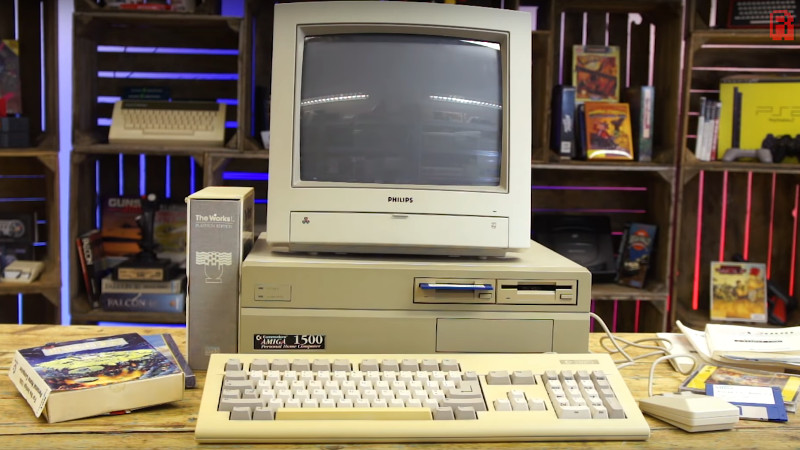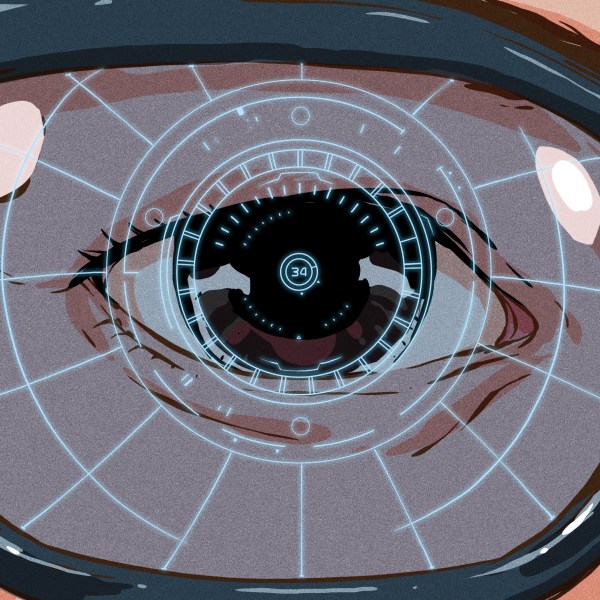If you were an Amiga enthusiast back in the day, the chances are you had an Amiga 500, and lusted after a 2000 or maybe later a 3000. Later still perhaps you had a 600 or a 1200, and your object of desire became the 4000. The amusingly inept Commodore marketing department repackaged what was essentially the same 68000-based Amiga at the bottom end of the range through the platform’s entire lifetime under their ownership, with a few minor hardware upgrades in the form of chipset revisions that added a relatively small number of features.
We’ve probably listed above all the various Amigas you’ll be familiar with, with a few exceptions you either didn’t have or only saw in magazines. The original A1000, the chipset-upgraded A500+, the CDTV multimedia platform, or the CD32 games console as examples. But there’s one we haven’t listed which you may never have seen unless you hail from the United Kingdom, and it’s an Amiga behind which lies a fascinating tale that has been unearthed by [RetroManCave].
In the late 1980s, Commodore sold the A500 all-in-one cased Amiga to consumers with marketing based heavily upon gaming, and the A2000 desktop Amiga to businesses with the promise of productivity software. Both machines had a 16-bit Motorola 68000 running at the same speed, with the A2000 having a lot of extra memory and a hard drive lurking within that case. The price difference between the two was inordinately high, creating a niche for an enterprising British company called Checkmate Computers to fill with their provocatively named A1500, a clever case for an A500 mainboard that gave it an expansion slot and space for that hard drive and memory.
This machine’s existence angered Commodore, to the extent that they vowed to eradicate the upstart by releasing their own UK-only A1500. The result, a comically badly concealed rebadge of an A2000 with two floppies and no hard drive, is something we remember seeing at the time, and dare we admit it, even lusting after. But the full story in the video below is well worth a watch for an engrossing insight into a little-known saga in one corner of the computing world during the 16-bt era. Towards the end it becomes a plug for the Checkmate Computers co-founder’s current Kickstarter project, but if that holds no interest for you then you are at least forewarned.
Of course, if you have either A1500 today, you might want an up-to-date graphics card for it.
Via Hacker News.

















Amiga is still running
http://www.amigaos.net/
Back in the storage area, lurks a complete Amiga 500, with a SCSI hard drive crammed inside.
Perhaps I’ll see if it still boots.
Who didn’t have a 500+???
I did. But I didn’t buy one.
It turned up unexpectedly as it did for hundreds if not thousands of other kids one xmas when they ordered an A500 and commodore replaced them with the A500+ without telling anyone.
Bit of a surprise come xmas day !!
so a company makes a case mod, response is make a lower cost computer
HAXORS!
“This machine’s existence angered Commodore, to the extent that they vowed to eradicate the upstart by releasing their own UK-only A1500.”
Kind of like the Apple clone market.
kind of… not at all!
These guys just bought normal A500 and put them in a different case, these guys didn’t clone anything!
Some clones were just that.
https://igotoffer.com/apple/macintosh-clones/
ahhh… then they weren’t clones either.
I always expected a clone to be a COPY of the hardware, some copies being identical other copies being slightly improved but allowing the same functions of the original hardware.
From where I come from, it means that in order to have a clone you need to build something from scratch… not putting the original hardware in a different case. The whole idea of clones was (if I understand correctly) to sell the original product for less, so how can you build a computer using hardware bought from the original manuf and sell it for a lower price?
okay… I think I get it now…
So these types of clones are all about making a cheap model look like a more expensive model (and not telling (actively) that there is a cheap model inside. Okay that makes sense.
And as history has proved us… it did for certain models… like the A1500.
I never realized it from this perspective. So on one side they aren’t clones and on the other side they are. Interesting viewpoint. Thanks Ostracus for pointing that out with the link.
I guess I’ve learning something today.
Thanks for sharing this Jenny it was an interesting story to cover. You’ll also find a follow up interview with Stephen on my channel in which he reminisces about the old days and talks a little more about the 1500+
Can’t remember an Amiga 3000 but there was an Amiga 4000 for sure.
Dude you can just Google Amiga 4000 it is a real thing.
I meant 3000 whoops
Can verify there was a 3000, as I own one. Bought used system for $50 back in 90s. Will dig it out someday, put it on ebay and buy myself something else I won’t use for decades….
i bough mine used back in ‘94. for more than $1100. ya lucky bastard
A3000 had a special “added” chip in it as well as the concave front end. I wish I could remember the chip…
I don’t remember man landing on the moon (before my time). Therefore….
(Trollololol)
The Motorola 68000 is an 32bit processor with a 24bit address bus and a 16bit data bus. All internal buses, registers and ALU were 32 bit. Calling it a 16bit processor would make the 68008 an 8bitter!
It was in fact known as a Sixteen Thirty Two configuration with 32bit internal and 16bit external, hence why the Atari ST was called ST for Sixteen Thirty Two.
Yes Atari called it that when naming their machine (never seen it used otherwise even there). Not a standard term and a very bad description anyway.
Either you are trolling or wrong. Go look it up. 32 bit (24 if counting address size) ISA in a 16 bit implementation. Well documented, never disputed by anyone with knowledge.
Reminds me of the rack of Amiga 3000 computers that were used for the Legend Quest, Virtual Reality gaming centre in Nottingham in the early 1990s. Awesome! You’d get given an electronic key (which had 4 pin sockets, so it probably connected to a small amount of serial EEProm, maybe microwire) which would store your character’s identity; then you’d put on the heavy VR visor and stand inside a padded, circular, pen to play the game. There was also a multi-player dragon hunting game played on a sort-of 3D chess board.
https://en.m.wikipedia.org/wiki/Virtuality_(gaming)
^ this, I take it.
Commodore really were a master class in totally knobbing up a great product with awful marketing / management.
Started on an A2000 back in 1990…ended with an A4000 around 2009. Workbench 1.3 was my favorite since it had the SAY program in the CLI. Many a wonderful night working with those wonderful machines. My A2000 had an A-2094 52MB SCSI drive with 4MB on card, a Supra Memory card with an extra 4MB of RAM, replaced 68K CPU with a 68010 (and added the 68010 library in the SYSTEM folder), A Bridgeboard 2088 (8088 XT which worked alongside the A2000, AND a 5.25″ floppy), Genlock card (on the far right next to the PSU (which needed a piece of insulation to keep it from touching and shorting out)), and a PBX board (which I used in college for my dorm mates). Later on, it was the Toaster 2000 and a TBC card for video. Those were the days. Still have the floppies, but the machines are long gone with their chips laying on some proto-boards with index cards beneath them. Man, I miss my Amigas.
Commodore will go down in history as having the best engineers and the most inept management in history.
The Amiga 1000 was years ahead of its competition, yet the commodore management were able to fail anyway.
Years of the worst decisions ever seen, we honestly thought evil clowns ran the company it was run so bad.
If only there was a time machine to go back and remove the 100% stupid from the management and do it different, it could have changed the entire computer world…. no microsoft, what a joy that would be.
Best comment on Commodore marketing.
If Commodore had bought KFC they would have changed the motto to warm dead birds in a cardboard bucket.
Totally true.
Imagine if Commodore had Compaq’s marketing team…. (Remember the John Cleese ads).
I’m pretty sure commodore didn’t have a marketing team, from the effectiveness it was likely all done by an unpaid intern on summer break.
It was more like they ignored their most unique product, i.e. Rebranded to Kentucky Fried Cow, cut down chicken to 10% of the menu and tried to sell generic burgers.
Pleasance in the UK seemed to have a clue, but it was a one man battle vs the corporate army of PC clone pushers.
There are so many messed up chances. Atari with the the APX program. They decided that they where a hardware company and not a mail order software company.
Tandy RadioShack. They had the TRS-80 and even had a hit but failed to build up the software and services side of the business. They could have been a one stop shop for both home users, school districts, business, and local governments.
Motorola for not building inexpensive reference designs and operating systems to take on the home and business market. They could have created a really good 6809 reference design and OS and pushed them out to anyone that wanted to make a clone and then manufactures could add better graphics and sound options over them then do the same with 68000 to take on IBM. They kind of made a half hearted try with what became the Coco.
DEC for not coming out with cheap home version of their PDP-8 and PDP-11 for home so they could take on the PC market because they did not want to mess up the large margin mini market that is not around anymore.
And Commodore wasted so much time and effort. I mean I think the C-128 is cool but what a waste of resources. They needed to get business software developers interested in it and really push it. It is amazing how well it actually did and for how long in the home market.
The CoCo is pretty much a copy of a Motorola app note for t the 6809.
Motorola knew what it had, went to Microware to create a better BASIC to make use of the 6809. The result was BASIC09 which added a lot of structure. And Microware decided it deserved an operating system, OS-9. Unix-like, it was multitasking, multiuser and all relocateable. It showed off the 6809 well, and was really the reason the 6809 saw good useage. And you could get it at Radio Shack, for the CoCo.
Radio Shack did really well in computers, and if they didn’t supply everything, others did. They were big in a small pond, until the pond got bigger.
Though they also committed the mismarketing sin with that, slapping the TRS-80 label on it, then it looked like an incompatible TRS-80 rather than a whole new thing. Kind of how I ended up with one, saw “TRS-80” on a $2 box at a yard sale, paid up with dreams of CP/M and discovered a CoCo 2 at home LOL